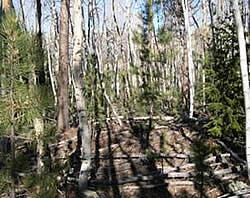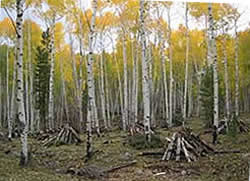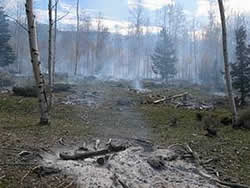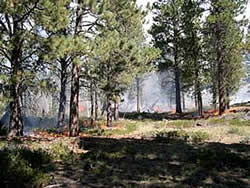
National Fire Plan Success Story
Yellowstone Canyon Fuels Reduction
Ashley National Forest, Duchesne/Roosevelt Ranger District
National Fire Plan - Fuels Reduction

An area prior to fuels treatments.

An aspen stand after treatments.

A treated area after the slash piles were burned.

A ponderosa pine stand broadcast burn.
The Yellowstone Canyon Fuels Reduction project is located on the Duchesne/Roosevelt Ranger District on the Ashley National Forest. Through a combination of treatments over five years this project will reduce fuel loading on the east and west sides of the Yellowstone Drainage, providing a buffer around private property and Forest facilities in the wildland urban interface. Because of these developments, this area has been delineated as, "high risk", when making decisions to authorize wildland fire use. After project completion we anticipate reducing the amount of area classified as "high risk" and allowing more fires to be managed for resource benefits.
This project is one more step toward a goal of managing the majority of naturally occurring fires for resource benefit, even in developed areas like Yellowstone Canyon. In the past, the potential consequences of letting a fire burn in this area would have been too hazardous. Additional benefits of this project include: promoting aspen regeneration, reducing conifer encroachment, and restoring fire to ponderosa pine and sagebrush fuel types where one or more fire return intervals have been missed (see pictures above and right). Reducing the risk of high-intensity wildfire in this area will also protect the Yellowstone River watershed and riparian habitat.
Treatments that have already been implemented include: mechanical thinning, piling, and burning of vegetation in ponderosa pine, mixed conifer, and aspen vegetation types including live, standing dead, and down and dead material. This work has been completed through two service contracts and work by Forest personnel. The majority of the mechanical work has been along the Yellowstone River adjacent to private lands, developed recreation facilities, and administrative facilities. This work involved treating 500 acres with well over 10,000 piles produced in the fall of 2006. The burning of this material began in the winter of 2006/2007 and was completed this fall. Additionally chipping has been used as a method of disposing this material.
The broadcast burning phase of the project began in the spring of 2007 and has continued into late summer/fall completing 300 acres of sagebrush burning and 1000 acres of ponderosa pine understory burning. These totals put us at approximately 1/4 of the proposed treatment area with 1000 acres of sagebrush left to be treated and 2000 acres of ponderosa pine. There is also a 3000 acre optional treatment area which consists primarily of lodgepole pine, aspen, and Engelmann spruce.
Contact: Jason Lawhon, Kings Peak FUM. (435) 790-7091, jlawhon@fs.fed.us